Tom's Hardware Verdict
The Trident Z Neo DDR4-3600 C14 is a solid option with formidable performance. But the kit's price tag might not easily convince consumers to pull the trigger.
Pros
- +
Strong out-of-the-box performance
- +
Very tight timings
- +
Good overclocking potential
Cons
- -
A bit pricey
Why you can trust Tom's Hardware
The Trident Z Neo is the latest iteration of G.Skill's Trident series, which has become a household name in the enthusiast circle. G.Skill markets the Trident Z Neo towards AMD's Ryzen 3000-series (codename Matisse) processors and the corresponding AMD X570 platform. That said, Intel owners can also tap into the Trident Z Neo's prowess without hiccups.
The Trident Z Neo lineup offers frequencies that span between DDR4-2666 and DDR4-3800, which might be a bit conservative for serious enthusiasts. Capacity-wise, the Trident Z Neo series does come in both dual- and quad-channel configurations, with capacities up to 128GB, though.

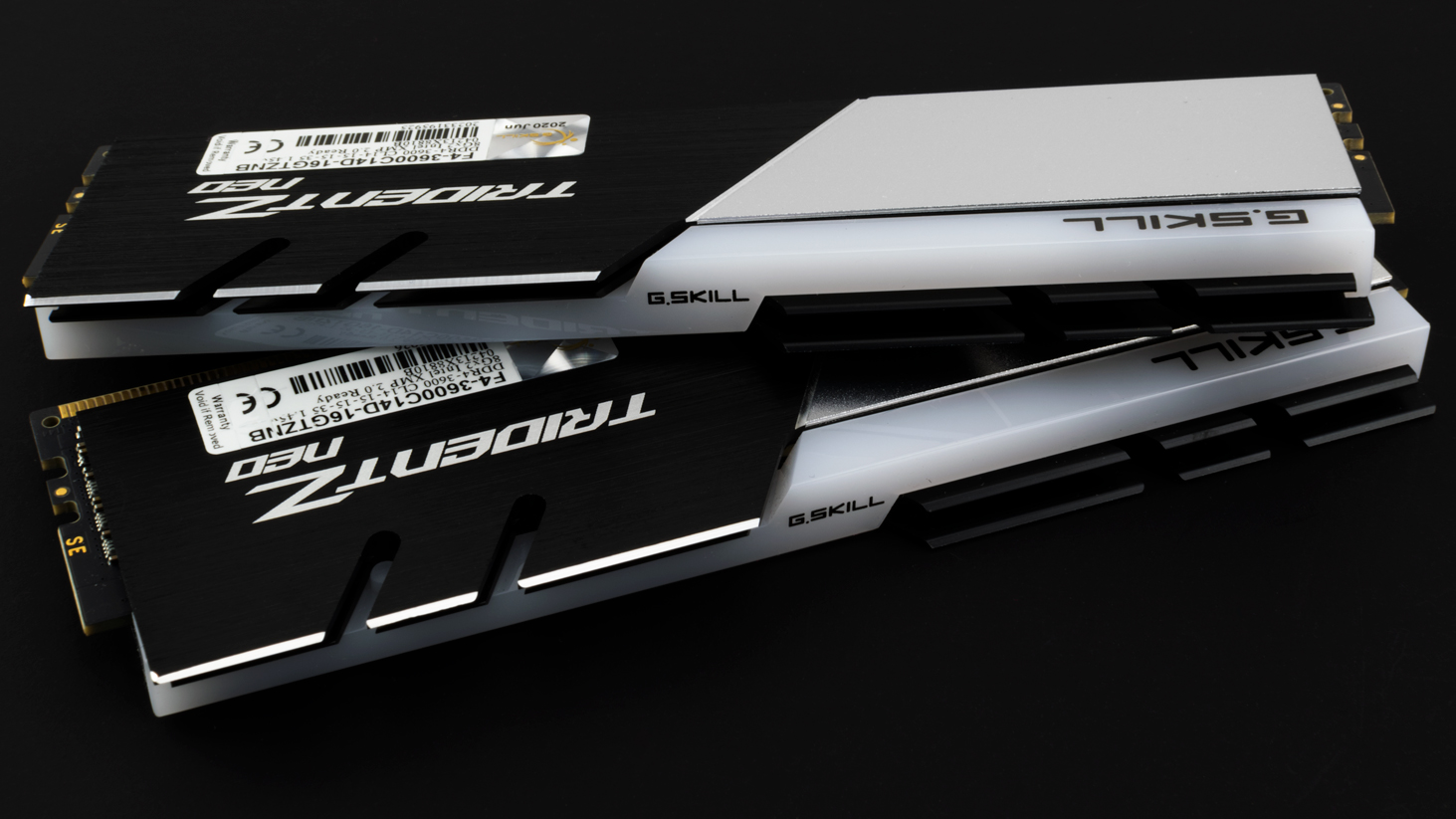

The Trident Z Neo series are a spinoff of G.Skill's Trident Z series, so it doesn't come as a shock that both series share similar aesthetics. G.Skill's characteristic tri-fin design returns once again, but the company revamped the heat spreader's color theme. Instead of a single solid color, the Trident Z Neo flexes a dual-toned combination where half of the heat spreader is dipped in silver to contrast the black portion of the heat spreader.
The Trident Z Neo modules stand 44mm (1.73 inches) tall, so they should fit under the majority of CPU air coolers. An RGB LED diffuser with customizable lighting adds a bit of bling to the Trident Z Neo modules, and G.Skill provides its proprietary Trident Z Lighting Control software for user customization.
If you don't fancy having another piece of software installed on your system, Trident Z Neo is compatible with multiple motherboard lighting software suites, including Asus Aura Sync, Gigabyte RGB Fusion 2.0, MSI Mystic Light Sync, and ASRock Polychrome Sync.
The kit, specifically model F4-3600C14D-16GTZNB, arrives in a dual-channel form with two single-rank 8GB memory modules. G.Skill fabricates the Trident Z Neo modules on a 10-layer black PCB that carries Samsung B-Die ICs that sport the K4A8G085WB-BCPB part number.
At stock, the Trident Z Neo modules operate at DDR4-2133 with 15-15-15-36 timings. However, they come with a XMP profile, which puts them in DDR4-3600 mode at 14-15-15-35 and ups the voltage to 1.45V. As usual, you can get the memory to run at its advertised frequency in no time on XMP-compatible platforms. For more on timings and frequency considerations, see our PC Memory 101 feature, as well as our How to Shop for RAM feature.
Get Tom's Hardware's best news and in-depth reviews, straight to your inbox.
Comparison Hardware
| Memory Kit | Part Number | Capacity | Data Rate | Primary Timings | Voltage | Warranty |
|---|---|---|---|---|---|---|
| G.Skill Trident Z Neo | F4-3600C14D-16GTZNB | 2 x 8GB | DDR4-3600 (XMP) | 14-15-15-35 (2T) | 1.45 Volts | Lifetime |
| Adata XPG Spectrix D60G | AX4U360038G14C-DT60 | 2 x 8GB | DDR4-3600 (XMP) | 14-15-15-35 (2T) | 1.45 Volts | Lifetime |
| TeamGroup T-Force Xtreem ARGB | TF10D416G3600HC14CDC01 | 2 x 8GB | DDR4-3600 (XMP) | 14-15-15-35 (2T) | 1.45 Volts | Lifetime |
| Adata XPG Spectrix D50 | AX4U360038G18A-DT50 | 2 x 8GB | DDR4-3600 (XMP) | 18-20-20-42 (2T) | 1.35 Volts | Lifetime |
| HP V8 | 7EH92AA#ABM x 2 | 2 x 8GB | DDR4-3600 (XMP) | 18-20-20-40 (2T) | 1.35 Volts | 5 Years |
| Lexar DDR4-2666 | LD4AU008G-R2666U x 2 | 2 x 8GB | DDR4-2666 | 19-19-19-43 (2T) | 1.20 Volts | Lifetime |
Our Intel test system consists of an Intel Core i7-10700K and MSI MEG Z490 Ace with the 7C71v11 firmware. Our AMD testbed has an AMD Ryzen 5 3600 and MSI MAG B550 Tomahawk that's on the 7C91vA1 firmware. Regardless of the platform, an MSI GeForce RTX 2080 Ti Gaming Trio is in charge of display duties for our RAM benchmarks.
Intel Performance
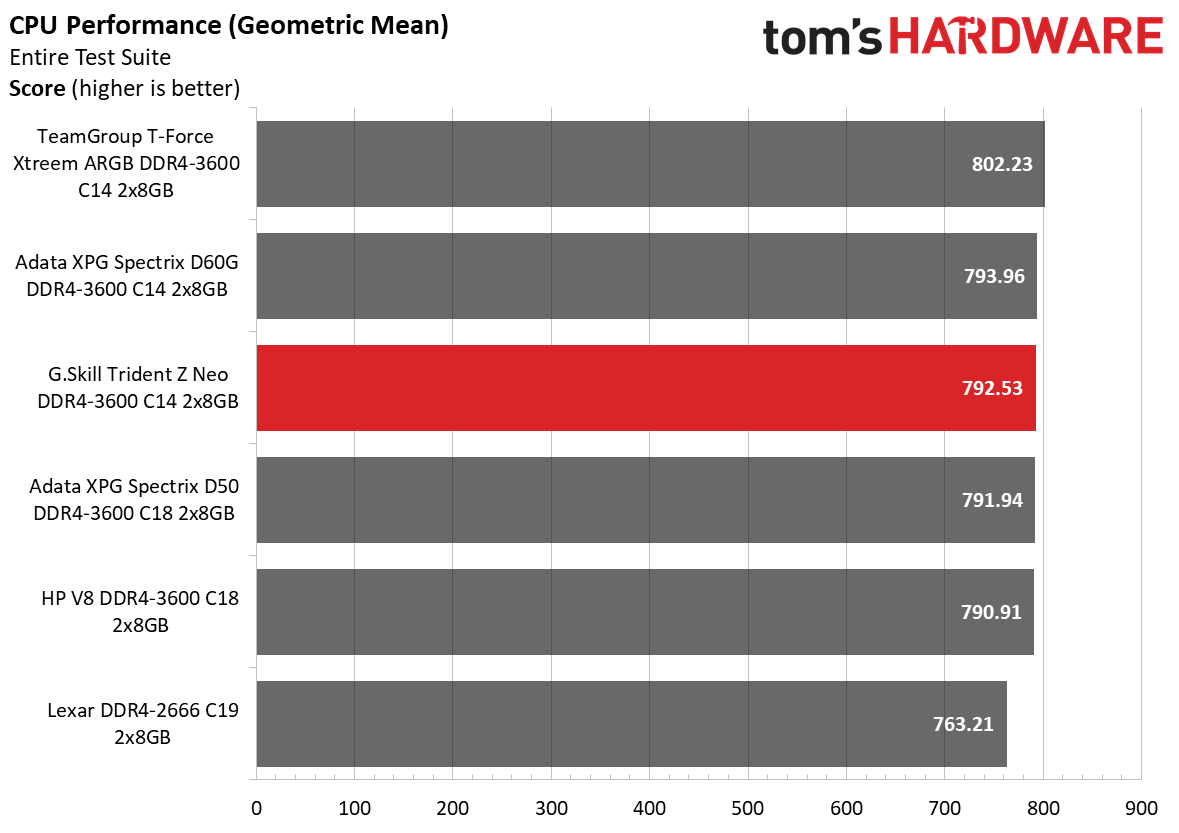








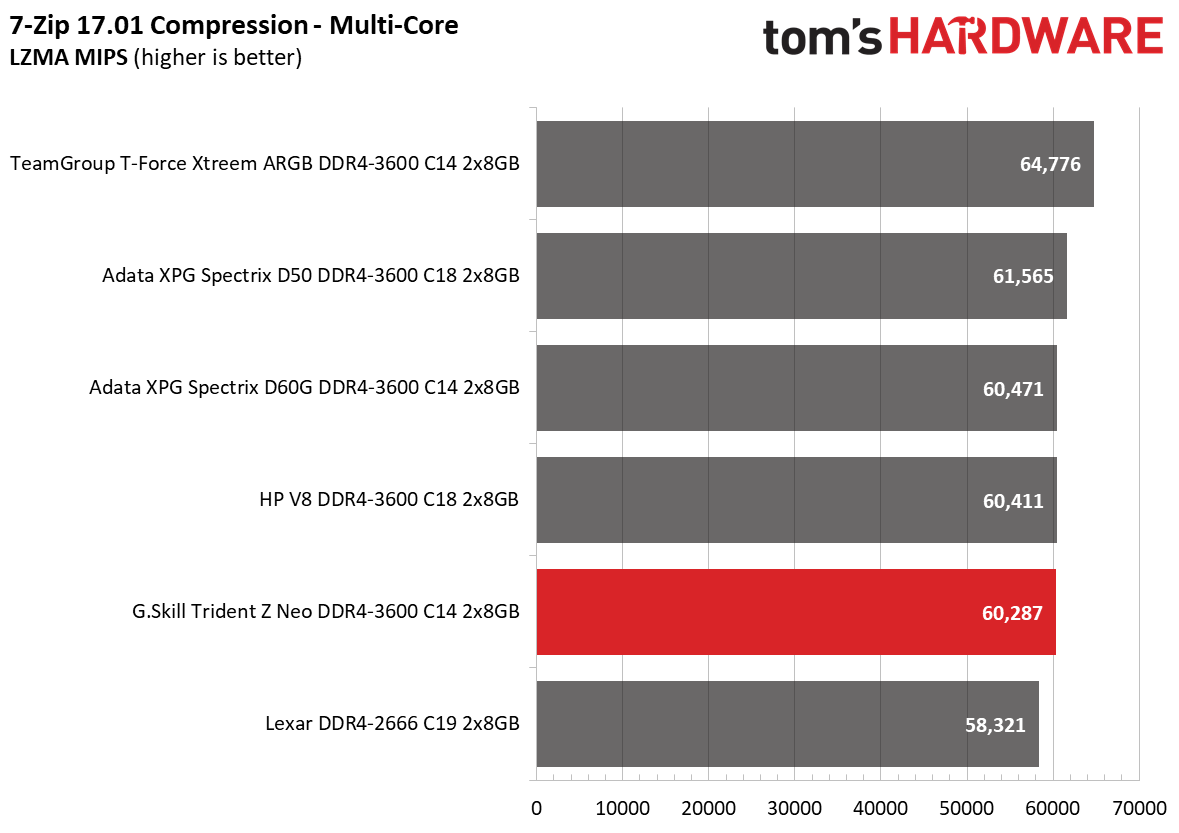

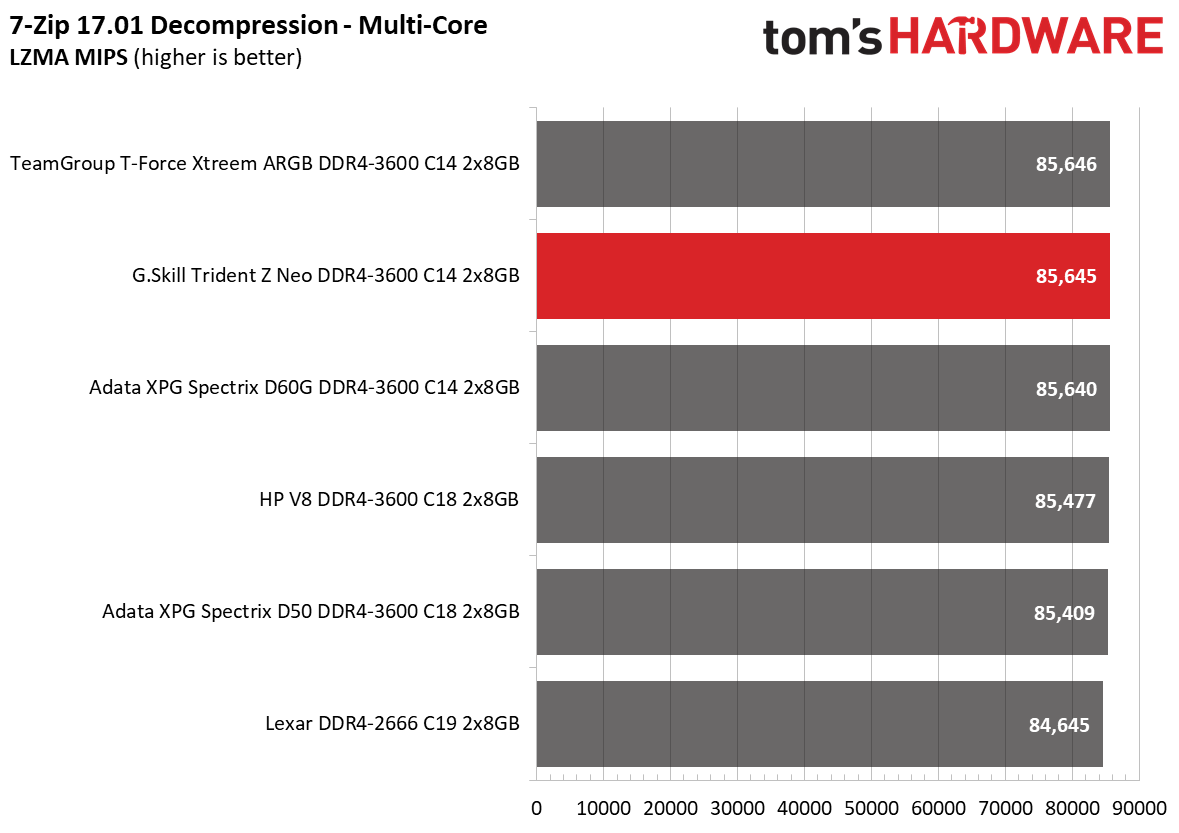


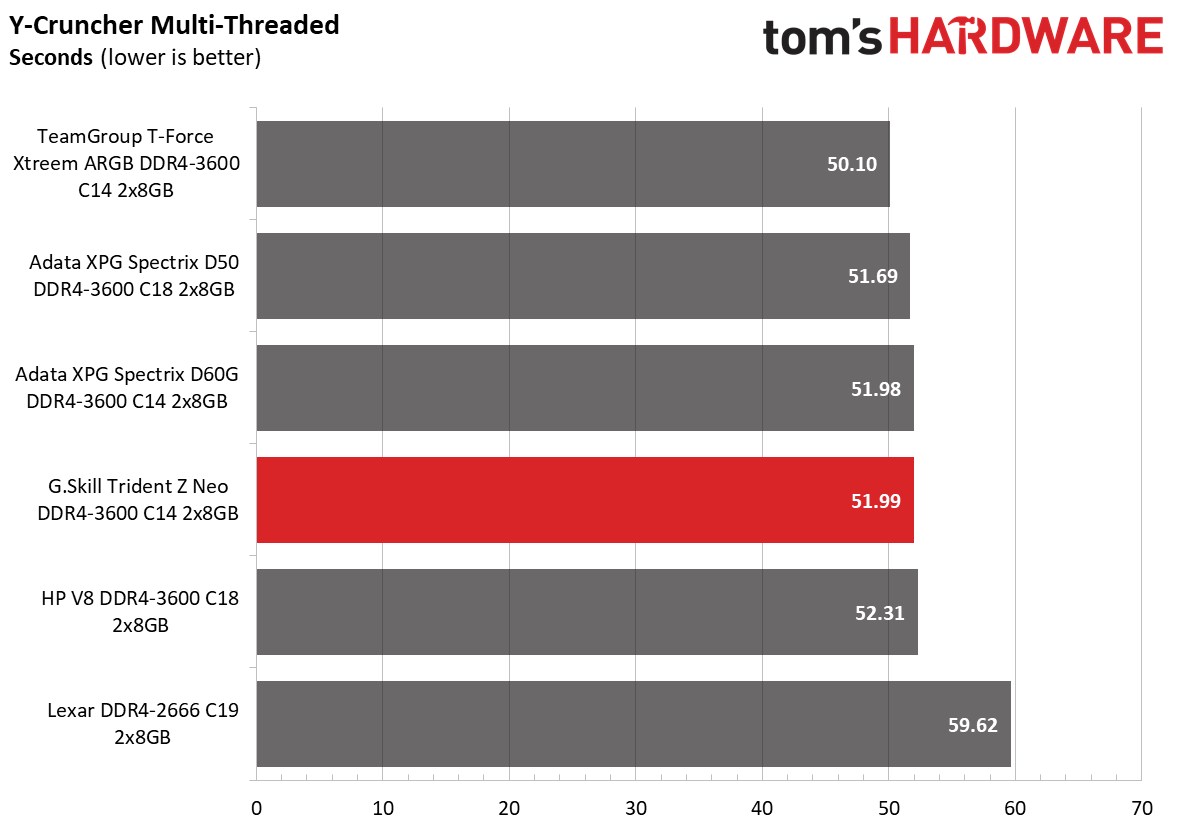




Overall, G.Skill's Trident Z Neo came in third place among our recently tested kits on the CPU and gaming performance charts. The memory kit was consistently in the top three positions, except for 7-Zip's compression test. The Trident Z Neo landed in the second-to-last spot there, with a 7.4% delta between it and the leading memory kit.
AMD Performance

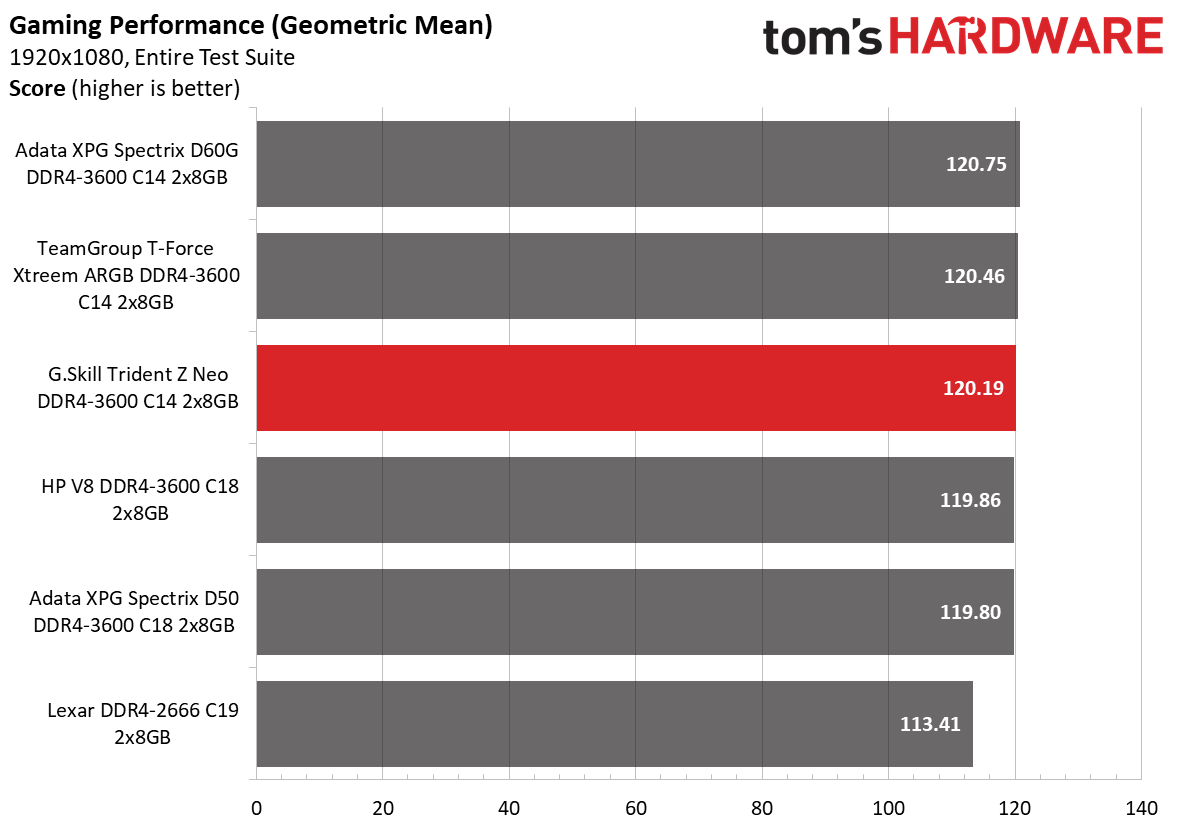

















The Trident Z Neo memory kit performed a lot better on the AMD platform, as it jumped from the third overall position to second place on the CPU performance chart. Once again, the 7-Zip compression test was the Trident Z Neo's Achilles heel – where it trailed the leading kit by 2.7%.
In terms of gaming performance, the Trident Z Neo continued to rank in third place overall. behind the TeamGroup and Adata competition.
Overclocking and Latency Tuning



At the default XMP voltage (1.45V), we pushed the Trident Z Neo to DDR4-4200 by loosening the timings to 19-19-19-39. The memory kit's overclocking capabilities fall in line with TeamGroup and Adata's DDR4-3600 C14 kits, which also employ Samsung B-Die ICs.
Lowest Stable Timings
| Memory Kit | DDR4-3600 (1.46V) | DDR4-4200 (1.45V) |
|---|---|---|
| G.Skill Trident Z Neo DDR4-3600 C14 | 13-16-16-36 (2T) | 19-19-19-39 (2T) |
| Adata XPG Spectrix D60G DDR4-3600 C14 | 13-15-15-35 (2T) | 20-19-19-39 (2T) |
| TeamGroup T-Force Xtreem ARGB DDR4-3600 C14 | 13-14-14-35 (2T) | 19-19-19-39 (2T) |
In order to tighten the Trident Z Neo's timings at DDR4-3600, we increased the operating voltage from 1.45V up to 1.46. The small voltage bump allowed us to reduce the CAS Latency from 14 to 13. However, we had to increase the tRCD, tRP and tRAS from 15-15-35 to 16-16-36 because the memory kit simply wasn't stable at the lower values.
Bottom Line
There is no doubt that the Trident Z Neo is one of the fastest DDR4-3600 16GB (2x8GB) memory kits that money can buy. You can argue if the memory modules look great or not, but their performance should satisfy the most demanding AMD or Intel motherboard owners. G.Skill binned the memory modules for the best performance, but left room for you to experiment, as well.
The Trident Z Neo DDR4-3600 C14 checks in at $174.99, placing it on the higher end of the DDR4-3600 pricing spectrum. However, the memory kit definitely deserves your consideration if you're looking for the best, no-hassle performance right out of the box.

Zhiye Liu is a news editor, memory reviewer, and SSD tester at Tom’s Hardware. Although he loves everything that’s hardware, he has a soft spot for CPUs, GPUs, and RAM.
-
Makaveli Not really surprised by the voltage requirement.Reply
My Gskill kit also requires 1.45v to hit 3600 at Cas 14.
This kit you are reviewing is very expensive in Canada about $350.
-
Akole I got C die Hynix, even CL16 is hard to lock down with tight timings under 1.40 volts, Is 1.40v bad/ for daily use?Reply -
Makaveli ReplyAkole said:I got C die Hynix, even CL16 is hard to lock down with tight timings under 1.40 volts, Is 1.40v bad/ for daily use?
From what I've seen 1.45v is the limit of what you should be using for daily use.
If you have active cooling blowing air over the ram then 1.5 would probably be max.
